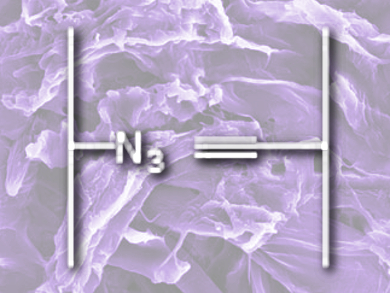Cellulose, the most abundant organic polymer on Earth, is a sustainable source of fibrous materials that is widely used in industry, mostly in the production of paper and cardboard. The hydrophilic surface of cellulose fibers can be modified to tune their properties, for example, by esterification or etherification.
Mohd Firdaus Yhaya, Universiti Sains Malaysia, Gelugor, Malaysia, and colleagues have investigated the use of azide-alkyne click reactions for the modification of commercial paper fibers. They modified the surface of fibers with azide groups and directly coupled them with propargylated fibers (see picture). The team synthesized a second fibrous material by bridging the azidated fibers using a crosslinker that contains alkyne groups. The reactions were performed in dimethylformamide (DMF) at 100 °C over 24 hours.
The properties of both types of linked fibers were analyzed and compared to untreated fibers using IR and NMR spectroscopy, as well as scanning electron microscopy (SEM). The modified fibers showed an increased mechanical stability and higher tensile strength in both dry and wet conditions. According to the researchers, these modified fibers could find applications in the packaging and printing industries.
- Crosslinking of fibers via azide–alkyne click chemistry: Synthesis and characterization,
Nur Syazwani Abd Rahman, Noor Afiqah Ahmad, Mohd Firdaus Yhaya, Baharin Azahari, Wan Ruslan Ismail,
J. Appl. Polym. Sci. 2016.
DOI: 10.1002/app.43576




